
views
Treating Minor Scrapes at Home
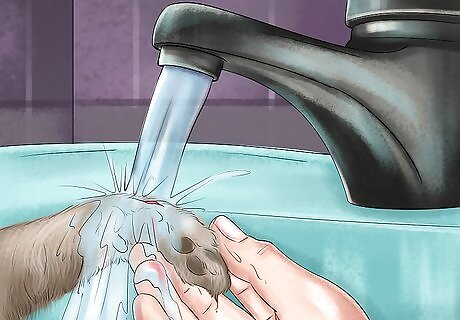
Place your cat’s paw under cool water. The water pressure should be low, not high; high water pressure can increase pain. The water will help clear away dirt and debris from your cat’s paw. If your cat resists you or is prone to scratching, then wrap your cat in a towel with just its head and the injured paw exposed.
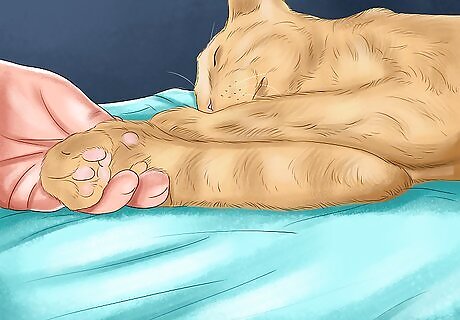
Inspect the footpad. Inspect your cat’s paw for foreign objects such as pebbles, burrs, and metal or glass shards. If you spot any foreign objects that can be easily removed with tweezers, then remove them with disinfected tweezers. Disinfect the tweezers by swabbing the tip of the tweezers with alcohol. If the foreign object is deeply lodged in your cat’s footpad, do not remove it with tweezers. Take your cat to the vet and have the vet remove it instead.

Apply pressure to the wound. Use a clean cloth or towel to apply gentle pressure to the wound. Hold the towel on the wound for one to two minutes. Minor cuts and scrapes will stop bleeding after a couple of minutes. Deeper cuts may take five to ten minutes to stop bleeding. If the wound keeps bleeding after 10 to 15 minutes, then take your cat to the vet to have the wound checked out.
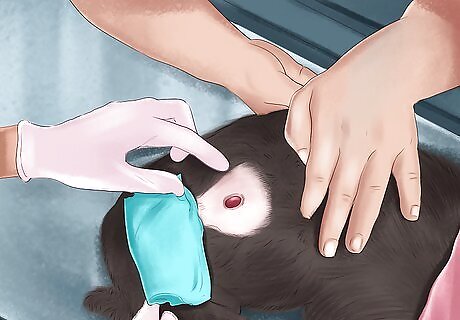
Clean the wound. Do this once the bleeding has slowed or stopped. Make an antibacterial solution by mixing warm water with a mild antibacterial soap. Fill a syringe with the solution. Squirt the solution onto the scrape until it is clean. Then rinse the paw with warm water. For the first three to five days, you should clean the wound two or three times a day.
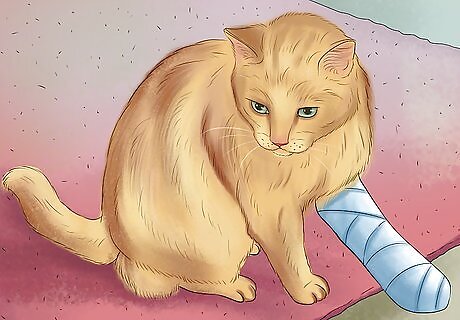
Bandage the wound. Place a couple of gauze pads on the wound to form a cushion. Secure the gauze with medical tape or a self-sticking product. Starting at the toes, begin to wrap the tape around your cat’s foot. Make sure to wrap all the way up to your cat’s ankle in order to secure the bandage in place. Avoid wrapping the bandage too tight. You should be able to stick two fingers between the bandage and your cat’s leg. If the cut is very minor, then bandaging may not be necessary.
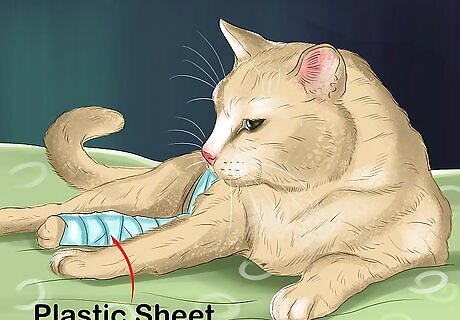
Tape a plastic bag over the paw to keep the bandage clean. As needed, protect the bandage using a plastic bag. You can use a regular Ziploc bag or another clear, plastic bag. Place the bag over the paw and use medical tape to secure it in place. Use the plastic bag minimally, as it encourages the paw to get hot and sweaty, which can lead to infection. It's best for when your cat is venturing outside or being active. The plastic bag will keep the bandage clean and dry. It will also prevent your cat from picking at the bandage.
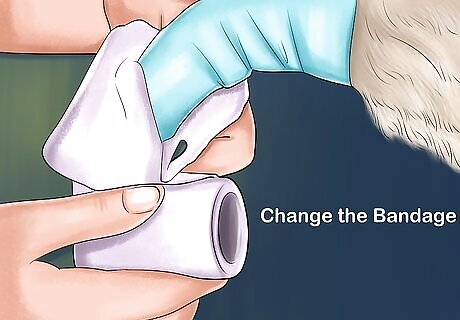
Change the bandage every day. Each time you change the bandage, inspect your cat’s paw for healing and any signs of an infection. If your cat’s paw is swollen, oozing pus, or has a foul odor, then it may be infected, or the bandage may be wrapped too tightly. Take your cat to the vet if you notice any of these signs. If the wound is still bleeding after three days, then take your cat to the vet to have its footpad checked out.
Treating Mild Injuries at the Vet

Rinse your cat’s footpad. Place your cat’s paw under cool, low-pressure water. The water will clear away dirt and debris so you can inspect the severity of the cut. If the cut is deep or contains foreign objects that cannot be removed with tweezers, then you will need to take your cat to the vet.

Apply pressure. Wrap your cat’s paw with gauze or a clean cloth. Apply gentle, but firm pressure to control the bleeding. Have someone drive you to the vet’s office. While on the way to the vet, hold the gauze in place until you reach the vet’s office. If you do not have someone to drive you to the vet, then secure the gauze with medical tape.
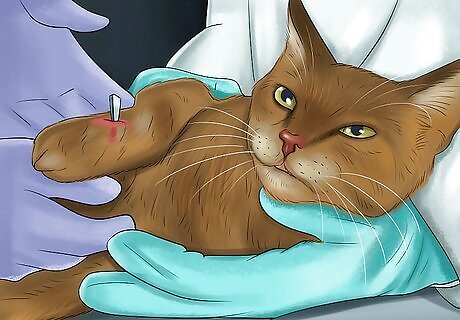
Remove foreign objects. Once you get to the vet’s office, the vet will sedate your cat. The sedation will enable your vet to remove any foreign objects that are deeply lodged in your cat’s footpad.
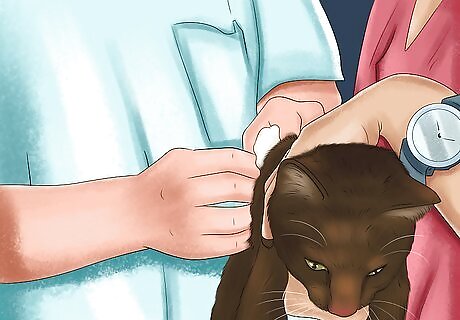
Have the wound cleaned. Your vet will flush the wound to remove dirt and debris. Then they will clean the wound with either chlorhexidine or povidone iodine.

Bandage the wound. Your vet will most likely apply a temporary bandage. Change the bandage according to your vet’s instructions. You may need to change the bandage daily or every two days, depending on the severity of the cut. Additionally, make sure to clean the wound according to your vet’s instructions. If you notice any signs of an infection while you are changing the bandage, such as swelling, oozing pus, and/or a foul smelling odor, then take your cat to the vet immediately. It's best to keep your cat inside while it's wearing a bandage.
Treating Severe Injuries at the Vet
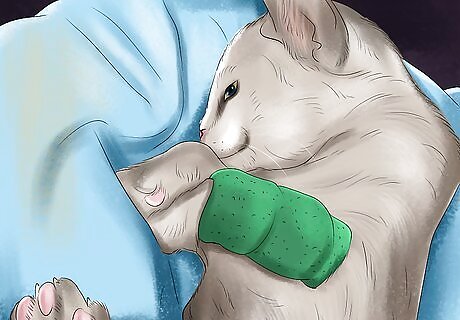
Wrap the wound in a clean towel. Secure the towel in place with tape or a self-sticking product. Then take your cat to the vet immediately. If someone can drive you to the vet, then apply gentle pressure to the wound to stop the bleeding until you arrive at the vet’s office.

Have the wound cleaned. Your vet will mostly likely sedate your cat in order to flush the wound. They will clean the wound with chlorhexidine or povidone iodine before suturing it.
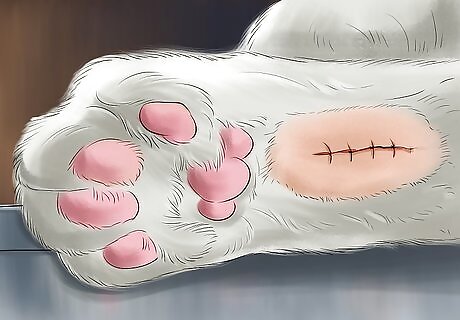
Suture the wound. For deep cuts, your vet will need to stitch the wound. The stitches will prevent the wound from opening up. This will promote proper healing of the wound. Your cat may also be given antibiotics to prevent any infections.
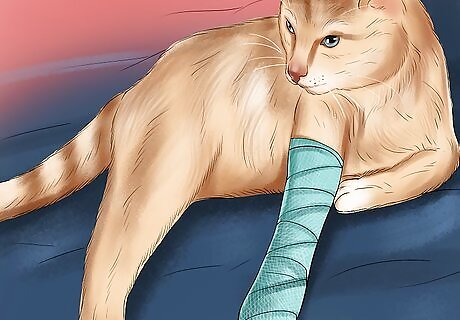
Apply a thick bandage. The thick bandage will protect the wound and stitches while your cat’s footpad is healing. Make sure to change the bandage and clean the wound according to your vet’s instructions. Depending on the severity of the wound, your vet may place a stint on your cat’s foot. The stint will help reduce any pressure applied to the wound when your cat walks. Your vet may also prescribe your cat antibiotics to prevent any infection.



















Comments
0 comment